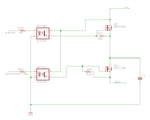yassin.kraouch
Advanced Member level 2
who have an idea of a system that equilibrate the charge between bettery in series ?
Follow along with the video below to see how to install our site as a web app on your home screen.
Note: This feature may not be available in some browsers.

Where did all that energy go?
Yes.so you are saying that using a capacitor to charge and discharge over a battery is inconvenient and i should better try a DC DC converter based on diodes and inductors?
Something like 12V(25% tolarence or more) to 12V battery charger circuit with input/output isolation(means,no common terminal between input 12v and output 12v)In that case what circuit do you recommend to bring charge from one battery to another?
I'm not aware of cell balancing circuits used in parallel connected batteries (except for Li-ion). It's also unusual for series connected lead acid and NiMH batteries, but mostly required for series connected Li-ion batteries..Battery charging/discharging equalizer often used for parallel connection of battery. At serial connection we dont have some problem like as in parallel connection.
You can use MC34167. It can step down and also it can step up. Look at the circuit named "step-up/down converter" in the datasheet.could there be something as simple as a boost circuit with 12V input that gives about 1, 2 or even 3, 4 Amps to variable voltage between 20 and 28V?
I'm not aware of cell balancing circuits used in parallel connected batteries (except for Li-ion). It's also unusual for series connected lead acid and NiMH batteries, but mostly required for series connected Li-ion batteries..